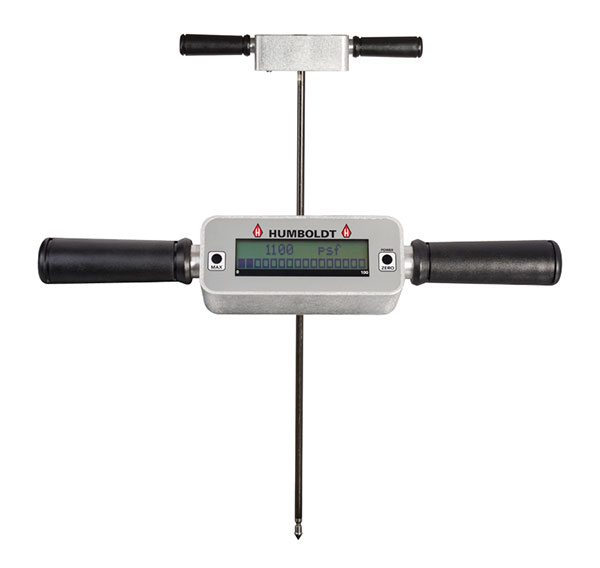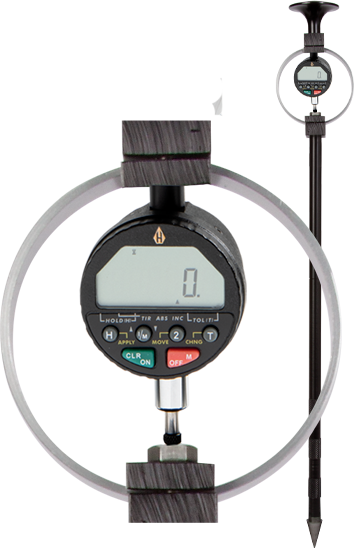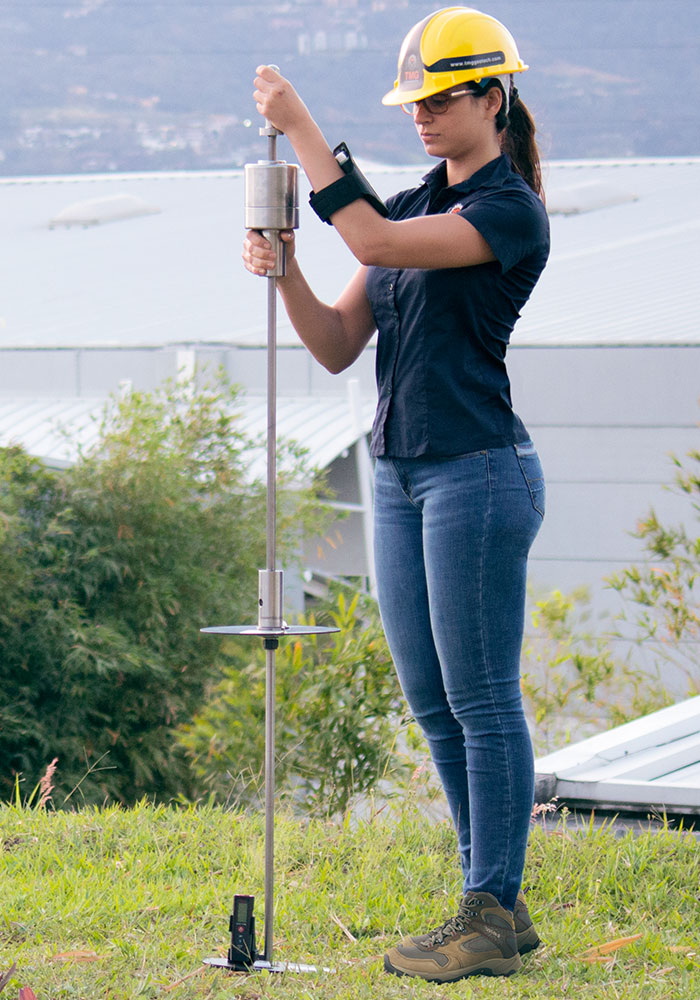Soil analysis, a vital aspect of geotechnical engineering, agricultural development, and environmental studies, is a process that requires precision, efficiency, and adaptability. It’s akin to reading the history book of the earth beneath our feet. However, traditional soil testing methods often pose challenges such as limited sample representation, multiple testing requirements, and potential inaccuracies. But what if there was a tool that could simplify this complex process? Enter the digital penetrometer, an advanced soil testing instrument that offers precise and effective measurements of soil properties, making testing and recording readings not only easy but also efficient. Imagine having a magic wand that provides a glimpse into the world beneath us, turning the complex language of the soil into understandable data. That is what a digital penetrometer does.
Key Takeaways
- Digital Penetrometers offer precise and reliable soil analysis through their dual-rod design, cone tip, and digital readout.
- Geotechnical engineers extensively use it to assess shallow foundations and determine soil consistency and classification.The integration of GIS technology, automation, and real-time data processing capabilities is set to revolutionize soil analysis with penetrometers.
Understanding the Digital Penetrometer

Often referred to as the Digital Static Cone Penetrometer, this powerful tool is characterized by a dual-rod design and a large digital readout. Much like a seasoned linguist who understands the nuances of a foreign language, the digital cone penetrometer also deciphers the language of the soil with its advanced features.
The operation of the penetrometer relies heavily on its cone tip and dual rod design. With this design, there’s no need to correct soil friction on the rod as the cone penetrates the material, which enhances the accuracy and reliability of the measurements. This ingenious design allows the device to deliver precise soil analysis, akin to a master chess player making calculated moves on the board.
Cone tip and dual rod design
The Digital Static Cone Penetrometer’s dual-rod design, which includes a starter rod, serves to negate the need for friction correction on the starter rod as the cone penetrates the material, guaranteeing accurate measurements. The intricate design of the dual-rod system is akin to a well-orchestrated symphony, with each part playing its role to perfection for the overall performance.
The cone tip, typically constructed from steel, further enhances the accuracy of measurements by minimizing soil disturbance during penetration testing. Imagine the precision of a skilled surgeon making a flawless incision. The cone tip works similarly, entering the soil surface with minimal disruption and offering accurate data about the soil’s condition.
Digital display and large digital readout
Penetrometers are equipped with a digital display and large readout, which allows testers to interpret and record the data efficiently during soil analysis. Imagine having a personal translator who not only deciphers a foreign language but also presents the information in an easy-to-understand manner. That’s what the digital display unit and large readout do – they translate the complex language of the soil into simple, understandable data.
The penetrometer’s digital display offers the following benefits:
- Boosts soil testing accuracy by offering precise resistance measurements during soil penetration
- Improves assessments of soil strength and compaction levels
- Displays data ranging from 0 to 1000 psi or 0 to 7000 kPa, encompassing a wide range of soil conditions
- Provides crucial data for soil analysis and planning, similar to a weather forecast that helps us plan our day.
Applications of Penetrometers in Geotechnical Engineering

Penetrometers have found a special place in the realm of geotechnical engineering. The digital penetrometer serves multiple purposes, like a Swiss Army knife, and applies to various tasks, from assessing shallow foundations to determining soil consistency and classification.
The use of a digital penetrometer for soil consistency and classification entails applying a set force to the soil with a cone or probe, followed by measurement of the soil’s penetration resistance. Much like a detective piecing together clues to solve a mystery, the penetrometer gathers vital data about the soil, providing insights for geotechnical engineering projects.
Shallow foundations
Shallow foundations, a key aspect of geotechnical engineering, can be effectively evaluated using digital penetrometers. These devices:
- Exert a predetermined force on the soil surface with a cone or probe
- Measure the resistance to penetration
- Enable precise determination of soil compaction levels
- Assess soil strength
Using digital penetrometers allows for accurate evaluation of shallow foundations.
When correctly calibrated and used, digital penetrometers prove highly accurate in evaluating soil strength for shallow foundations. Imagine a pilot navigating through turbulent weather using sophisticated instruments. In a similar vein, the digital penetrometer guides engineers through the complexities of soil analysis, providing reliable data for assessing shallow foundations.
Soil consistency and classification
The penetrometer plays a crucial role in determining soil consistency and classification. Much like a barista expertly assessing the quality of coffee beans, the penetrometer measures the resistance of the soil to penetration, providing a metric for evaluating soil consistency.
By determining the soil’s compaction level and consistency, the device can classify a variety of soil types, ranging from stable rock to Type C soils. This is crucial for various engineering applications including assessing soil compaction and density, identifying soil compaction zones, determining soil layer depths, and informing irrigation and planting strategies based on the soil’s level.
Comparing Penetrometers with Other Soil Testing Methods

Comparing penetrometers with other soil testing methods is like comparing a race car to a bicycle. Though both serve the purpose of transportation, the race car offers speed, efficiency, and a host of advanced features that the bicycle simply can’t match. Likewise, digital penetrometers offer several advantages over traditional soil testing methods.
Despite the merits of traditional methods, they often come with many constraints including limited sample representation, multiple testing requirements, and potential inaccuracies. In contrast, digital penetrometers deliver precise assessments of soil strength and compaction through digital readings, simplifying the interpretation and analysis of data.
Efficiency and accuracy
By leveraging digital technology to accurately and efficiently measure and record soil penetration resistance, digital penetrometers ensure precise measurements, resulting in superior prediction accuracy compared to other methods. Imagine a world-class athlete who excels in speed, precision, and consistency. The digital penetrometer performs similarly, delivering efficient and accurate soil analysis.
Several factors enhance the efficiency of digital penetrometers in soil testing, including:
- The choice of penetrometer
- Consideration of soil factors like water content and bulk density
- Ensuring accurate readings
- Accounting for soil compaction
- The use of advancements like digital displays and automated functions for real-time data collection.
Site selection and adaptability
Digital penetrometers are not just efficient and accurate; they’re also adaptable. Like a chameleon that adjusts to its surroundings, a digital penetrometer can be tailored to suit varying site conditions and soil testing requirements.
The device, vital for determining soil compaction levels, can be used under diverse site conditions, including construction sites with a wide array of soil conditions. When choosing a location for conducting tests with a digital penetrometer, factors such as local conditions such as:
- soil type
- accessibility
- moisture content
- surface conditions
- calibration
- expertise
- budget
- testing documentation
When constructing a building, the bearing capacity of the soil should be considered, which can be determined through standard or other tests or modified proctor tests, and analyzing the test result.
Tips for Maximizing the Use of Penetrometers
Just like any high-performance machine, getting the most out of a digital penetrometer requires knowledge and skill. Here are some tips to maximize the use of this versatile tool.
Calibration is critical. Much like a well-tuned musical instrument, a properly calibrated penetrometer ensures precise and accurate readings. Moreover, good maintenance practices, including proper care, cleaning of the instrument, frequent calibration, and regular inspection for signs of damage or wear, can go a long way in maintaining the device’s performance.
Proper calibration and maintenance
For accurate soil analysis with a digital penetrometer, calibration is key. Just as a well-calibrated compass points true north, a well-calibrated penetrometer provides accurate soil data.
If not calibrated correctly, a penetrometer’s accuracy can be impacted by factors like:
- Ambient environmental conditions (pressure, temperature, and humidity)
- Bias or zero error
- Harsh manufacturing conditions
- Fluctuating temperatures
- Elapsed time
Regular calibration before each use makes testing and recording readings easily accurate and ensures reliable readings, making testing and recording readings easy.
Adapting to specific project requirements
Much like tailoring a suit for a perfect fit, adapting the penetrometer to meet project-specific requirements is crucial. You can fine-tune the digital penetrometer to suit a wide range of soil testing requirements by:
- Adjusting the penetration depth
- Changing cone sizes
- Adding sensors
- Customizing data output
The customization of the digital penetrometer can differ when dealing with various soil types due to factors such as soil density, moisture content, and compaction characteristics. Whether you’re dealing with a shallow foundation assessment or a large-scale soil survey, the digital penetrometer can be tailored to meet your project’s specific needs.
Penetrometers and the Future of Soil Analysis

As we look to the future, digital penetrometers are poised to bring about a revolution in soil analysis. The potential for greatly enhanced accuracy and efficiency in soil data collection and interpretation lies in the integration of digital penetrometers with GIS and remote sensing technologies. Imagine the possibilities when mapping accuracy meets real-time monitoring.
On the horizon are further advancements in soil analysis, including:
- Sensor integration
- Creation of portable devices
- Automation
- Remote monitoring
- Incorporation of data management systems to streamline the soil analysis process
Like a rocket set to launch into the cosmos, digital penetrometers, which aid technicians in their work, are set to revolutionize soil analysis.
Integration with GIS and remote sensing technologies
The integration of GIS technology with a Penetrometer involves the collection of soil penetration data using the penetrometer and subsequent georeferencing of the data with GPS coordinates. Just as a GPS guides a traveler to their destination, GIS and remote sensing technologies guide the digital penetrometer to enhanced data analysis and visualization.
Using a penetrometer in combination with remote sensing technologies allows for the assessment of soil compaction and moisture levels. Integrating penetration data with remote sensing data, such as hyperspectral imaging, achieves the following benefits:
- More precise and comprehensive information on soil conditions across larger areas
- Improved understanding of soil compaction and moisture levels
- Enhanced ability to make informed decisions regarding soil management and irrigation practices
This integrated approach can greatly contribute to optimizing agricultural productivity and sustainability.
Automation and real-time data processing
In the age of automation, digital penetrometers keep pace with the times. Technological advancements have developed more efficient and accurate measurement systems, facilitating automated soil testing processes. Imagine a maestro conducting a symphony, where every note is perfectly timed and every instrument is in perfect harmony. That’s the level of precision and efficiency offered by automated digital penetrometers.
Real-time data processing in penetrometers is achieved through the use of sophisticated sensors and data acquisition systems. The digital penetrometer captures the rhythm of the earth beneath us, analyzing and interpreting data in real time to provide immediate insights into the soil’s condition.
Summary
In today’s digital age, the penetrometer stands as a beacon of innovation in soil analysis. From its advanced cone tip and dual rod design to its large digital readout, it provides accurate, efficient, and user-friendly soil testing. Whether assessing shallow foundations or determining soil consistency and classification, the digital penetrometer outperforms traditional soil testing methods in terms of efficiency, accuracy, site selection, and adaptability.
As we look to the future, the integration of penetrometers with GIS and remote sensing technologies, along with advancements in automation and real-time data processing, promises to revolutionize soil analysis. It’s akin to opening a new chapter in the book of soil analysis, one that is written in the language of digital technology.
Certified MTP has the largest selection of soil testing supplies, showcasing industry-leading brands for Hand auger tools and soil sampler equipment, Soil Moisture Testing Equipment, field density test equipment, Soil Strength Test Equipment, and Dual Mass Dynamic Cone Penetrometer.
Frequently Asked Questions
What is a digital penetrometer?
The Digital Static Cone Penetrometer (DSCP) evaluates soil consistency and determines compaction levels and bearing capacity. It assesses shallow foundations and pavement subgrades effectively. It features a large digital readout for easy testing and recording of readings.
What is the function of a penetrometer?
A penetrometer is a tool used to measure the resistance of soils, fruits, food samples and subsurfaces to penetration. It uses a plunger, needle, or cone to evaluate firmness, moisture content, approximate unconfined shear strength, tenderness, and vertical penetration.
What is the penetrometer test used for?
A penetrometer test employs a diagnostic tool to measure the density, compaction, consistency, or penetration of materials. It determines the extent and depth of subsurface compaction. It provides a rapid empirical method for assessing these qualities.
What did the penetrometer tell you?
The penetrometer measured the force in pounds per square inch (PSI) required for penetration.
How is the dual-rod design of a Digital Static Cone Penetrometer significant?
The dual-rod design of a Digital Static Cone Penetrometer eliminates the need for soil friction correction, resulting in more accurate and reliable readings.
Related Blogs for Digital Penetrometer
Pocket Penetrometer Conversion Chart: Soil Strength Analysis
Humboldt Penetrometer: Soil Testing Precision
Pocket Soil Penetrometer: Guide to Soil Strength Analysis
ASTM D6951: Dynamic Cone Penetrometer in Pavement Tests
Understanding the Penetrometer Cone: Guide to Soil Testing
Mastering Penetrometer Soil Analysis for Agriculture
Penetrometer for Soil Testing: The Ultimate Guide
Penetrometer: Understanding Soil Compaction
What is a Pocket Penetrometer: Definition and Function

